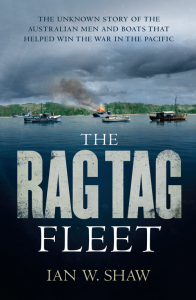- Author
- Book reviewer and Editorial Staff
- Subjects
- Biographies and personal histories, History - WW2, Book reviews, Naval Engagements, Operations and Capabilities
- Tags
-
- RAN Ships
- None noted.
- Publication
- December 2017 edition of the Naval Historical Review (all rights reserved)
By Ian W Shaw. Published by Hachette Australia, Sydney, 2017. Soft cover of 310 pages with black & white photographs. Available from booksellers and online from $32.99 but discounts readily available.
The following review by George Franki first appeared in Vol. 90 No. 5, September-October 2017 edition of Reveille published by the NSW Branch of the RSL and is likely to be the last written testament by George who passed over the bar on 28 August 2017, aged 90. It is reproduced with the kind permission of the RSL and members of the Franki family.

The Rag Tag Fleet tells the story of the US Army Small Ships Section which operated between May 1942 to January 1947 transporting supplies, ammunition and mail from Australia to Allied troops serving in the South West Pacific campaigns. The Section supplemented the work of regular naval vessels, in many cases going into areas too small or remote for regular vessels to navigate. The fleet consisted of over 3,000 vessels by war’s end and was crewed by 3,327 Australian civilians, mostly under or over military age or unfit and not eligible for regular service. It is of interest that one crew member was George Howell, an Australian WWI Victoria Cross winner, who was 50 when he took part in the invasion of Leyte in a ‘small ship’.
The scheme was co-ordinated in Australia by a US Army officer, Captain Sheridan Fahnestock, who accompanied General Douglas MacArthur to Australia in 1942. Fahnestock requisitioned a fleet of fishing trawlers, sailing craft, tugs, ferries and speed boats and recruited crews. The original fleet was later supplemented by a vessel building programme in Australia.
The operation of the ‘small ships’ was called Mission X, whose headquarters were in the Grace Building in York Street, Sydney. These operations were hazardous and there were some fatal casualties. Crew members are now eligible for Australian medals – the 1939-45 Star, the Pacific Star, the War Medal and the Australian Service Medal.
Ian Shaw’s book is well researched, a highly detailed account of the forgotten fleet of the US Army Small Ships Section and is highly recommended.
Reviewed by George Franki
Now we come to George’s own story
A good way to start is with a little romance. In this case we have a beautiful young Australian woman, Margaret Johnson (?) setting out on an adventure to visit her sister who was then living in Paris. She travels from Sydney in an Italian passenger ship and quickly falls for the charms of a fellow passenger, the handsome Francesco. They marry and settled with his parents in Italy.
A year later, on 6 June 1927, George Thomas Franki was born in Genoa. With Margaret missing her family they returned to Sydney. George was a bright young fellow but had an unfortunate stutter which remained with him for the rest of his life. Through determination he was largely able to overcome this difficulty and he excelled at school.
On 12 July 1945 the 18 year old George was mobilised for service as an Ordinary Seaman with initial training at HMAS Cerberus. Rated AB on 12 July 1946 he saw service in the South West Pacific in HMA Ships Bungaree and Shoalhaven. Demobilised on 20 May 1947 he entered the Faculty of Dentistry at the University of Sydney. Upon graduation in 1953 he joined the Royal Australian Army Dental Corps as a Captain, later becoming a Major. George saw service in Australia, Japan and Korea and as a keen sportsman was an inter-service swimming representative.
As a lover of books and seeking a change in direction he undertook a Diploma in Librarianship at the University of New South Wales where he graduated in 1965 and then worked in the Library of that University becoming the Biomedical Librarian until his retirement in 1985. He wrote several books including A History of Dentistry in NSW 1945 – 1995 and co-authored Mad-Harry – Australia’s Most Decorated Soldier. Later in retirement George rediscovered his naval friends at the Naval Historical Society where he was a most valued member with editing skills par excellence. He is greatly missed, especially by fellow bibliophiles.




